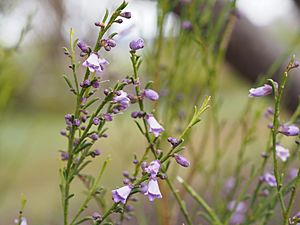Bale-hook eremophila facts for kids
Quick facts for kids Bale-hook eremophila |
|
|---|---|
 |
|
| Eremophila dichroantha leaves and flowers | |
| Scientific classification | |
| Genus: |
Eremophila (plant)
|
| Species: |
dichroantha
|
| Synonyms | |
|
|
Eremophila dichroantha, also known as the bale-hook eremophila, is a beautiful flowering plant. It belongs to the figwort family, which scientists call Scrophulariaceae. This plant is special because it is only found in the south-west part of Western Australia. It grows as a shrub with many branches that point upwards, making it look a bit like a broom. It has small, hooked leaves and lots of pretty violet or lilac-coloured flowers.
Contents
What Does Bale-Hook Eremophila Look Like?
The bale-hook eremophila is a tall shrub with many branches that grow upwards. These branches are smooth, meaning they have no hairs. They also have many small, raised bumps called glands. This plant can grow to be about 0.5 to 3 metres (1.6 to 9.8 feet) tall. The ends of the branches and the younger leaves are shiny and sticky because of a natural substance called resin.
The leaves grow one after another along the stems. They are thin and look almost like needles. Most leaves are about 5 to 13 millimetres (0.2 to 0.5 inches) long and about 1 millimetre (0.04 inches) wide. Each leaf has a curved, hooked tip at its end.
Flowers and Fruit
The flowers grow in groups of 3 to 5 where the leaves meet the stems. They are on a stalk that is about 2 to 5 millimetres (0.08 to 0.2 inches) long and feels sticky when it's young. There are 5 brownish, overlapping parts called sepals. These sepals are shaped like eggs or spears and are about 2 to 3.5 millimetres (0.08 to 0.14 inches) long. They are smooth except for long hairs on their edges. The sepals are sticky and stay on the plant even after the flowers have finished blooming.
The petals are about 5 to 9 millimetres (0.2 to 0.35 inches) long. They are joined together at the bottom to form a tube. The petals are usually violet or lilac-coloured on the outside, but sometimes they can be white. Inside the tube, they are white with violet spots. The petal tips have short, flat hairs on the inside. The petal tube is mostly smooth on the outside, but the inside is full of long, spidery hairs. The 4 stamens, which are the parts that produce pollen, are completely hidden inside the petal tube.
This plant flowers from August to November. After the flowers, it produces oval-shaped, hairy fruits that are about 2 to 3 millimetres (0.08 to 0.12 inches) long.

How Was Bale-Hook Eremophila Named?
This plant was first officially described in 1904 by a scientist named Ludwig Diels. He wrote about it in a scientific journal. The second part of its scientific name, dichroantha, comes from two Ancient Greek words. Díkhrōs means "two-coloured," and ánthos means "flower." This name likely refers to the different colours seen on the petals, like violet outside and white with violet spots inside.
Where Does Bale-Hook Eremophila Grow?
The bale-hook eremophila is found in many places and is quite common in certain areas of Western Australia. You can find it between towns like Balladonia, Esperance, and Lake King. It also grows in places like the Cape Arid area and near Norseman. These areas are part of different natural regions in Western Australia, including the Coolgardie, Esperance Plains, and Mallee regions.
Is Bale-Hook Eremophila Protected?
The Western Australian Government's Department of Parks and Wildlife has looked at the bale-hook eremophila. They have classified it as "not threatened," which means it is not currently in danger of disappearing.
Can Bale-Hook Eremophila Be Grown in Gardens?
This eremophila is a lovely plant for gardens because of its arching branches and the many blue to purple flowers it produces in spring. The sepals also stay on the plant for a long time after flowering, adding to its beauty.
It can be a bit tricky to grow new plants from cuttings (small pieces of the plant) or from seeds. However, it's easier to grow new plants by a method called grafting. This is where a part of the bale-hook eremophila is joined onto the rootstock (the root system) of another plant called Myoporum.
This plant can grow in most types of soil and likes either full sun or some shade. It is also good at handling dry conditions (drought resistant) and cold weather (frost resistant). If you grow it, you should only trim it lightly.

